 Facebook
Facebook
 X
X
 Instagram
Instagram
 TikTok
TikTok
 Youtube
Youtube
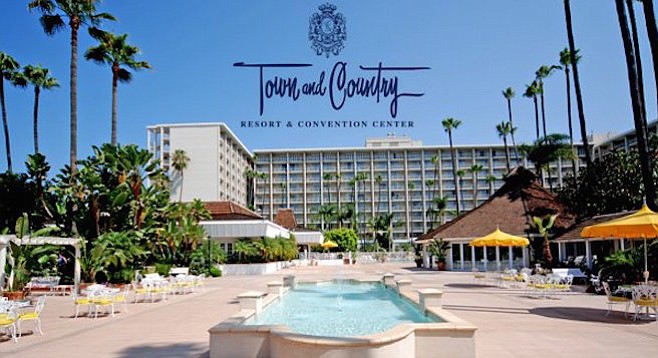
On December 30, Bill Earl was admiring the woody surfing murals on the walls of the Terrace Café in the Town and Country Resort and Convention Center when he found out it was set to be demolished within the next two years.
Earl has fond memories of staying at the hotel with his parents in 1962. He was told by a resort employee that they want to make the front of the hotel more inviting and driver-friendly and that the bungalows around the pool area will be demolished and replaced with a family water park.
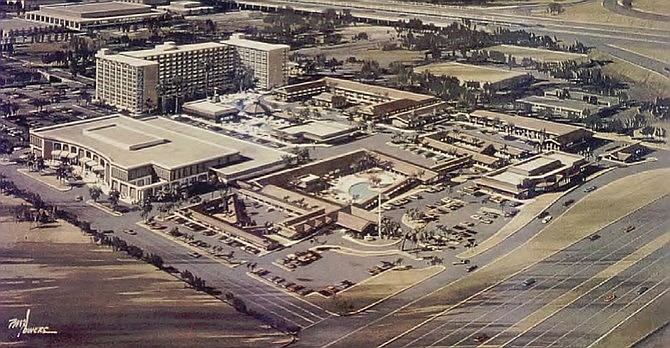
The Town and Country Resort located at the 500 Hotel Circle North was the first hotel in Mission Valley. Built by local developer Charlie Brown in 1953, it was initially a 46-room motor inn. The resort expanded over the years to include more rooms and, after Brown’s death in 1967, a convention center.
The hotel was also the first in San Diego to have coffeemakers in guests' rooms. (Disclosure: my grandfather was friends with Brown. The coffeemakers Brown purchased didn’t work so he brought them to my grandfather to troubleshoot. My grandfather told my mom that Brown was ribbed for building a hotel in Mission Valley because there was nothing there.)

Originally called the Lanai Coffee Shop, the café was built in 1969 with tropical Tiki-Polynesian decor made popular after World War II.
I was unable to determine anything about the demolition or the murals after speaking to a couple café employees. I did get some answers from Todd Majcher, vice president with Lowe Enterprises. Lowe is a developer and has been a co-owner of the hotel with the Brown family since 2014.
According to Majcher, the surfing murals are fairly new and while they may go, the café isn’t going anywhere. “We’re going to peel back the layers of additions and renovations, to take it back to what it used to look like when it was first built. Over the years, as architectural styles change, it’s gone from a fairly cool mid-century modern building to something that really doesn’t reflect the original architecture.”
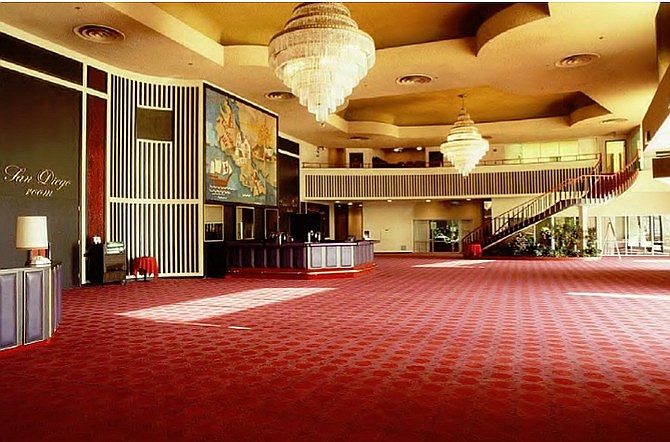
Majcher also talked about plans to bring back to the surface some tile mosaic murals in the convention center’s Atlas Ballroom foyer that have been covered up for 20 years. “We’re not going to be heavy-handed about it; our intent is to let this place reveal itself.”
Majcher said the resort’s planned $80 million makeover will begin in early 2018 with demolition plans for about 25 percent of the resort to make space for four seven-story residential buildings with approximately 840 apartments.
“The buildings that will be taken down are the oldest and most dilapidated single-story buildings," said Majcher. "In addition, the Bella Tosca spa will go as well as Kelly’s Steakhouse, which will allow for the residential units.”
Majcher said that future apartment tenants may have use of some of the hotel’s amenities such as room service and housekeeping. There are no plans to change the name of the resort.
“We’re not trying to turn it into a non-contextual, overly contemporary place. A lot of developers spend significant time trying to create an authentic experience for people — for us it would be a missed opportunity to do that at Town and Country when we already have the makings for the real thing.”
High on Majcher’s list are curved pools with water slides for children, pool bars, shade lounges, and cabanas. Plans are to reduce the 954 hotel rooms to 700 and the convention center from 212,000 square feet to 177,000 square feet.
“We worked really hard on right-sizing the hotel, understanding that traffic is a huge concern for people. We're reducing the hotel size to offset any residential impacts such as traffic. Our project won’t add any additional trips.”
Majcher said he has worked closely with the community and local planning group to ensure that his project lines up with Mission Valley’s community plan update (currently being updated).
Dottie Surdi, chair of the Mission Valley Planning Group, said that she is “very pleased with the mixed-use concept” of the project.
On March 24, 2016, there was a Historic Resources Board hearing to determine historic designation of one of the hotel ballrooms (Le Baron Hotel Garden Ballroom). The board’s vote was 5 to 3 in favor of designation, but it needed 6 votes to pass. The board is supposed to have 11 members but currently only has 10 members and on that day only 8 boardmembers were present.
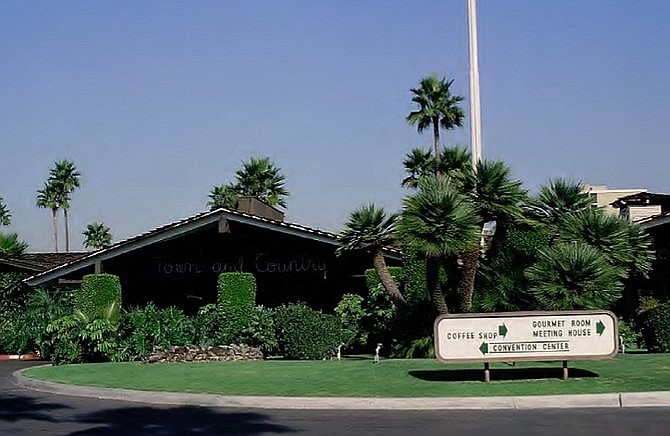
Bruce Coons from Save Our Heritage Organisation spoke at the hearing. Coons said that more than just the ballroom was eligible for historical designation. He said that it was a significant part of San Diego history and that it has the most extensive use of ranch-style architecture in the county. While city staff recommended designation of the ballroom, they did not for any other part of the hotel. It was also mentioned by Coons and a boardmember that they hoped some of the (approximately 2000) palm trees remain, some being original to the hotel.
Majcher was not opposed to the ballroom's historic designation but confirmed that it will be demolished to make space for the residential units.
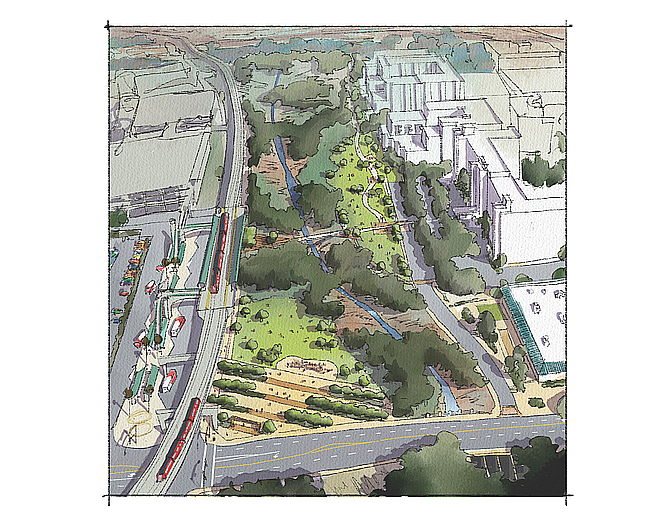
Concurrent with the hotel renovation in early 2018, but before the residential project gets going, Majcher said they will be creating a 3.3-acre public park as well as restoring 8.2 acres of the nearby river corridor. The latter will involve removing invasive plant species and bringing back in native plants.
The environmental impact report was out for 45-day public review in August 2016, but it was discovered later that the water-system analysis was inadvertently omitted. On December 9, this went out for a 30-day public review (ending January 8).


On December 30, Bill Earl was admiring the woody surfing murals on the walls of the Terrace Café in the Town and Country Resort and Convention Center when he found out it was set to be demolished within the next two years.
Earl has fond memories of staying at the hotel with his parents in 1962. He was told by a resort employee that they want to make the front of the hotel more inviting and driver-friendly and that the bungalows around the pool area will be demolished and replaced with a family water park.

The Town and Country Resort located at the 500 Hotel Circle North was the first hotel in Mission Valley. Built by local developer Charlie Brown in 1953, it was initially a 46-room motor inn. The resort expanded over the years to include more rooms and, after Brown’s death in 1967, a convention center.
The hotel was also the first in San Diego to have coffeemakers in guests' rooms. (Disclosure: my grandfather was friends with Brown. The coffeemakers Brown purchased didn’t work so he brought them to my grandfather to troubleshoot. My grandfather told my mom that Brown was ribbed for building a hotel in Mission Valley because there was nothing there.)

Originally called the Lanai Coffee Shop, the café was built in 1969 with tropical Tiki-Polynesian decor made popular after World War II.
I was unable to determine anything about the demolition or the murals after speaking to a couple café employees. I did get some answers from Todd Majcher, vice president with Lowe Enterprises. Lowe is a developer and has been a co-owner of the hotel with the Brown family since 2014.
According to Majcher, the surfing murals are fairly new and while they may go, the café isn’t going anywhere. “We’re going to peel back the layers of additions and renovations, to take it back to what it used to look like when it was first built. Over the years, as architectural styles change, it’s gone from a fairly cool mid-century modern building to something that really doesn’t reflect the original architecture.”

Majcher also talked about plans to bring back to the surface some tile mosaic murals in the convention center’s Atlas Ballroom foyer that have been covered up for 20 years. “We’re not going to be heavy-handed about it; our intent is to let this place reveal itself.”
Majcher said the resort’s planned $80 million makeover will begin in early 2018 with demolition plans for about 25 percent of the resort to make space for four seven-story residential buildings with approximately 840 apartments.
“The buildings that will be taken down are the oldest and most dilapidated single-story buildings," said Majcher. "In addition, the Bella Tosca spa will go as well as Kelly’s Steakhouse, which will allow for the residential units.”
Majcher said that future apartment tenants may have use of some of the hotel’s amenities such as room service and housekeeping. There are no plans to change the name of the resort.
“We’re not trying to turn it into a non-contextual, overly contemporary place. A lot of developers spend significant time trying to create an authentic experience for people — for us it would be a missed opportunity to do that at Town and Country when we already have the makings for the real thing.”
High on Majcher’s list are curved pools with water slides for children, pool bars, shade lounges, and cabanas. Plans are to reduce the 954 hotel rooms to 700 and the convention center from 212,000 square feet to 177,000 square feet.
“We worked really hard on right-sizing the hotel, understanding that traffic is a huge concern for people. We're reducing the hotel size to offset any residential impacts such as traffic. Our project won’t add any additional trips.”
Majcher said he has worked closely with the community and local planning group to ensure that his project lines up with Mission Valley’s community plan update (currently being updated).
Dottie Surdi, chair of the Mission Valley Planning Group, said that she is “very pleased with the mixed-use concept” of the project.
On March 24, 2016, there was a Historic Resources Board hearing to determine historic designation of one of the hotel ballrooms (Le Baron Hotel Garden Ballroom). The board’s vote was 5 to 3 in favor of designation, but it needed 6 votes to pass. The board is supposed to have 11 members but currently only has 10 members and on that day only 8 boardmembers were present.

Bruce Coons from Save Our Heritage Organisation spoke at the hearing. Coons said that more than just the ballroom was eligible for historical designation. He said that it was a significant part of San Diego history and that it has the most extensive use of ranch-style architecture in the county. While city staff recommended designation of the ballroom, they did not for any other part of the hotel. It was also mentioned by Coons and a boardmember that they hoped some of the (approximately 2000) palm trees remain, some being original to the hotel.
Majcher was not opposed to the ballroom's historic designation but confirmed that it will be demolished to make space for the residential units.

Concurrent with the hotel renovation in early 2018, but before the residential project gets going, Majcher said they will be creating a 3.3-acre public park as well as restoring 8.2 acres of the nearby river corridor. The latter will involve removing invasive plant species and bringing back in native plants.
The environmental impact report was out for 45-day public review in August 2016, but it was discovered later that the water-system analysis was inadvertently omitted. On December 9, this went out for a 30-day public review (ending January 8).
Comments